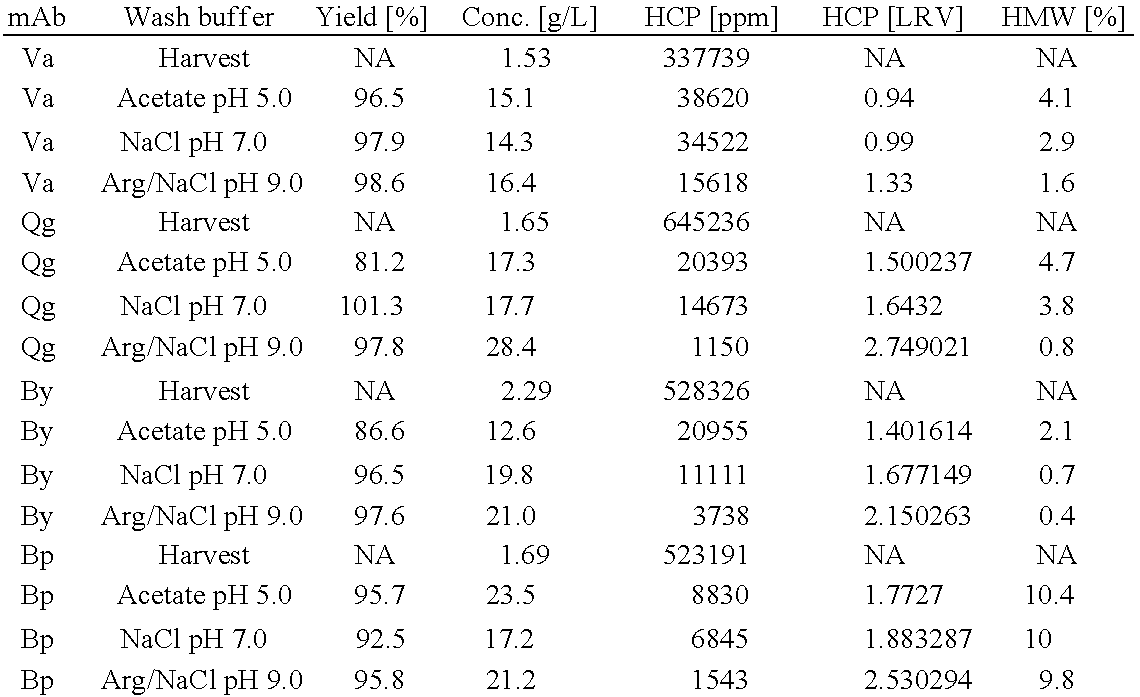Wash solution and method for affinity chromatography
a technology of affinity chromatography and wash solution, which is applied in the direction of immunoglobulins, separation processes, peptides, etc., can solve the problems of inefficient removal of contaminants during the washing step, corrosion, flammability, and high cost of hazardous waste disposal, and achieve efficient and robust wash solution. , high yield
- Summary
- Abstract
- Description
- Claims
- Application Information
AI Technical Summary
Benefits of technology
Problems solved by technology
Method used
Image
Examples
example 1
Comparison of Arginine / Nonbuffering Salt Wash Solution to Other Wash Solutions
[0047]In this example, the effectiveness of various wash solutions to remove impurities from an antibody-containing solution during affinity chromatography is compared. More specifically, three wash solutions are compared: one containing no arginine and no nonbuffering salt at pH 5.0, the second containing nonbuffering salt but no arginine at pH 7.0, and the third containing both nonbuffering salt and arginine at pH 9.0.
[0048]Clarified, mammalian cell culture supernatants containing between 1.5 and 2.5 g / L antibody are harvested by depth filtration and purified using an ALC column, in particular a Protein A column (GE Healthcare), according to the conditions described below in Table 1:
TABLE 1Operating Conditions for Protein A ColumnCVRes. time *StepBuffer**(min)Equilibra-20 mM NaH2PO4 / Na2HPO4, pH 7.064tionLoadCell-free harvestq.s.4Wash 1Variable (See Table 2)34Wash 220 mM NaH2PO4 / Na2HPO4, pH 7.034Elution20...
example 2
Comparison of Various Arginine / Salt Wash Solutions
[0059]In this example, the effectiveness of additional wash solutions, containing different amounts of nonbuffering salt and / or arginine at different pH values, to remove impurities during affinity liquid chromatography (ALC) is compared. The chromatography conditions used in this Example are as set forth in Table 8 below.
TABLE 8Operating Conditions for Protein A ColumnCVRes. time *StepBuffer**(min)Equilibra-20 mM NaH2PO4 / Na2HPO4, pH 7.034tion 1Equilibra-Identical to wash buffer 134tion 2LoadCell-free harvestq.s.4Wash 1Variable (See Table 9)64Wash 220 mM NaH2PO4 / Na2HPO4, pH 7.034Elution50 mM Acetic acid54CIP0.1M NaOH34Storage20 mM Acetic acid / Sodium acetate,542% Benzylalkohol, pH 5.1* Res. Time = residence time;** CV, column volume
[0060]The wash solutions compared in this Example are set forth below in Table 9:
TABLE 9Additional Variant Wash Solutions for First WashSolu-AbbreviationtionBufferof buffer120 mM NaH2PO4 / Na2HPO4, 1000 mM Na...
example 3
Comparison of Basic pH to Physiological pH in Wash Solutions
[0066]In this example, an analysis of the pH as a parameter of the wash solutions on the removal of HCPs and HMWs is conducted and shows the superiority of basic pH conditions. Affinity liquid chromatography (ALC) using the conditions set forth in Table 8 in Example 2, is performed on a cellular harvest of mAb-Va, with slightly different levels of HMW and HCPs.
[0067]The wash solutions compared in this Example are set forth below in Table 11:
TABLE 11Wash Solutions with Varying pH Valuesfor First Wash (on mAb-Va)Solu-AbbreviationtionBufferof buffer120 mM NaH2PO4 / Na2HPO4, 1000 mM NaCl,W2-N7pH 7.0213.2 mM Na2HPO4, 250 mM Arginine HCl, 1MW6-Arg / N7NaCl, pH 7.03~289 mM * Tris, 250 mM Arginine-HCl, 1MW3b-NaCl, pH 8.9Arg / N8.9* No NaOH was used for pH adjustment
[0068]The percent yield, percent HMW species in eluate, and reduction in HCP (expressed as LRV) for purification of mAb-Va, using the three different wash solutions shown in T...
PUM
| Property | Measurement | Unit |
|---|---|---|
| Molar density | aaaaa | aaaaa |
| Molar density | aaaaa | aaaaa |
| Molar density | aaaaa | aaaaa |
Abstract
Description
Claims
Application Information
 Login to View More
Login to View More - R&D
- Intellectual Property
- Life Sciences
- Materials
- Tech Scout
- Unparalleled Data Quality
- Higher Quality Content
- 60% Fewer Hallucinations
Browse by: Latest US Patents, China's latest patents, Technical Efficacy Thesaurus, Application Domain, Technology Topic, Popular Technical Reports.
© 2025 PatSnap. All rights reserved.Legal|Privacy policy|Modern Slavery Act Transparency Statement|Sitemap|About US| Contact US: help@patsnap.com


